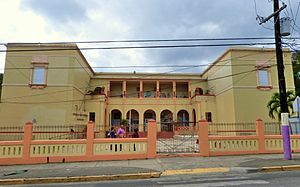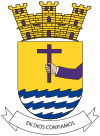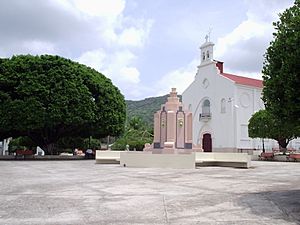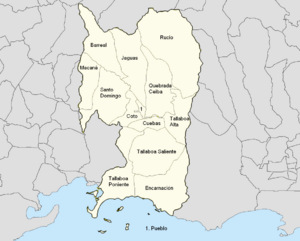Peñuelas, Puerto Rico facts for kids
Quick facts for kids
Peñuelas
Municipio Autónomo de Peñuelas
|
|||
|---|---|---|---|
|
Town and Municipality
|
|||

Daniel Webster School in Peñuelas
|
|||
|
|||
| Nicknames:
"La Capital del Güiro" ("The Güiro Capital"), "El Valle de los Flamboyanes" ("The Valley of the Poinciana Trees")
|
|||
| Anthem: "Así es mi pueblo" | |||

Map of Puerto Rico highlighting Peñuelas Municipality
|
|||
| Sovereign state | |||
| Commonwealth | |||
| Settled | 1754 | ||
| Founded | August 15, 1793 | ||
| Founded by | Diego de Alvarado | ||
| Barrios | |||
| Area | |||
| • Total | 137.42 km2 (53.06 sq mi) | ||
| • Land | 114 km2 (44 sq mi) | ||
| • Water | 23.42 km2 (9.04 sq mi) | ||
| Population
(2020)
|
|||
| • Total | 20,399 | ||
| • Rank | 59th in Puerto Rico | ||
| • Density | 148.443/km2 (384.465/sq mi) | ||
| • Ethnic groups (2000 Census) |
83.3% European 4.5% African 0.3% Arawak 0.1% Asian 0.1% Native Hawaiian/PI 9.4% Some other ethnicity 2.4% Two or more ethnicities |
||
| Demonym(s) | Peñolanos | ||
| Time zone | UTC−4 (AST) | ||
| ZIP Code |
00624
|
||
| Area code(s) | 787/939 | ||
| Major routes | |||
Peñuelas is a town and municipality in Puerto Rico. It is located on the southern coast of the island. Peñuelas is south of Adjuntas and west of Ponce. The Caribbean Sea is to its south.
Peñuelas is known by two fun nicknames. It is called "La Capital del Güiro" (The Güiro Capital). A güiro is a musical instrument. It is also known as "El Valle de los Flamboyanes" (The Valley of the Royal Poinciana trees). These trees have beautiful, bright red-orange flowers. In 2020, about 20,399 people lived in Peñuelas.
Contents
History of Peñuelas
Early Settlement and Founding
In 1754, a group of workers settled near the Tallaboa Bay. They slowly moved inland to more fertile land. This area later became the town of Peñuelas. By 1788, about 80 families lived in the valley. They mainly focused on farming and raising animals.
The town of Peñuelas was officially founded on August 25, 1793. It was founded by Diego de Alvarado.
Growth and Changes
By 1874, Peñuelas had grown quite a bit. A census that year showed a population of 9,206 people. The town had four main roads and several streets. It also had a brick church and a town hall. The town hall was also used as a prison, barracks, and cemetery.
In 1902, a law was passed to combine some towns. Peñuelas became part of the municipality of Ponce. But in 1905, this law was changed. Peñuelas became its own municipality again.
Modern History and Hurricane Maria
On September 20, 2017, Hurricane Maria hit Puerto Rico. Peñuelas was greatly affected. About 1,500 homes were completely destroyed. Another 500 homes were partly damaged. The strong winds and heavy rain caused many landslides in the northern part of Peñuelas.
Geography of Peñuelas
Peñuelas is located on the southern coast of Puerto Rico. It is slightly west of the island's center.
Rivers in Peñuelas
Several rivers flow near Peñuelas. These include:
- Río Guayanés
- Río Macaná
- Río Tallaboa
Barrios of Peñuelas
Like all municipalities in Puerto Rico, Peñuelas is divided into smaller areas called barrios. The main town area, with its municipal buildings and central square, is called "el pueblo".
Here are the 13 barrios of Peñuelas:
Within these barrios, there are even smaller communities. For example, the Santo Domingo community is in the Santo Domingo barrio. The Tallaboa community is in the Encarnación barrio.
Special Communities
Some communities in Puerto Rico are called Comunidades Especiales (Special Communities). These are areas where people might face challenges. In Peñuelas, some of these special communities include the Maldonado neighborhood (Los Chinos), Santo Domingo barrio, Comunidad Caracoles, and Comunidad La Moca in Tallaboa Alta.
Population of Peñuelas
After the Spanish–American War, Puerto Rico became a territory of the United States. In 1899, the first census of Puerto Rico was taken. It showed that Peñuelas had a population of 12,129 people.
| Historical population | |||
|---|---|---|---|
| Census | Pop. | %± | |
| 1900 | 12,129 | — | |
| 1910 | 11,991 | −1.1% | |
| 1920 | 13,598 | 13.4% | |
| 1930 | 13,278 | −2.4% | |
| 1940 | 14,789 | 11.4% | |
| 1950 | 14,931 | 1.0% | |
| 1960 | 14,887 | −0.3% | |
| 1970 | 15,973 | 7.3% | |
| 1980 | 19,116 | 19.7% | |
| 1990 | 22,515 | 17.8% | |
| 2000 | 26,719 | 18.7% | |
| 2010 | 24,282 | −9.1% | |
| 2020 | 20,399 | −16.0% | |
| U.S. Decennial Census 1899 (shown as 1900) 1910-1930 1930-1950 1960-2000 2010 2020 |
|||
Things to See and Do in Peñuelas
Peñuelas has 15 beaches for visitors to enjoy.
Landmarks and Places of Interest
Here are some of the main attractions in Peñuelas:
- Charco La Soplaera: A natural pool of water.
- El Convento Cave: A cave to explore.
- Don Angel Pacheco Monument: A monument honoring a local figure.
- Guilarte Forest: A beautiful forest area.
- Unknown Soldier's Monument: A tribute to soldiers.
- Parque de Bombas: The old firehouse, now a historical site.
- La Negra Cocola: An old steam locomotive on display in the main town square.
- Peñuelas Museum of Art and History: A place to learn about the town's past and art.
- Cancha Carlos Rentas Gallardo: A sports court in Quebrada Ceiba.
Economy of Peñuelas
The main industries in Peñuelas are manufacturing and oil refining.
Symbols of Peñuelas
The municipality of Peñuelas has its own official flag and coat of arms.
Flag of Peñuelas
The flag has a bright yellow bottom, which represents the sun and life. In the center, there is a purple cross. This cross stands for Christianity and spiritual life. The purple cross reaches all corners of the yellow flag.
Coat of Arms of Peñuelas
The stone wall above the shield represents how long the town will last. The cross on the shield represents Santo Cristo de la Salud. This is a belief that a holy figure "stopped the sea from flooding Peñuelas." The purple arm on the shield stands for the priesthood and the town itself. The yellow color represents the sun. The blue and white colors symbolize the ocean. The regal flag shows faith in Christianity, with the motto "In God We Trust."
Culture and Events
Festivals and Events
Peñuelas celebrates its patron saint festival in late October or early November. This festival, called Fiestas Patronales de San Jose, is a religious and cultural event. It usually includes parades, games, local crafts, amusement rides, traditional food, and live entertainment.
Other fun festivals and events in Peñuelas include:
- Endless Fun Festival – April
- Festival of the Cross – May
- National Güiro Festival – May
- Festival of the Flamboyan Tree – Summer
- Children's Festival – August
- Folk Festival – October
- The Cantatas – December
Sports in Peñuelas
Peñuelas has an AA Amateur Baseball team called Los Petroleros de Peñuelas. This name means "The Peñuelas' Oilers." It comes from a time when Peñuelas had a large oil and chemical complex called CORCO. Even though CORCO closed in 1980, the name for the baseball team stuck.
Peñuelas is also the hometown of Luis "Tite" Arroyo, a famous baseball player. Another local sports hero is Ivelisse Echevarria. She was inducted into the International Federation Softball Hall of Fame in 2003. Many consider her the best softball pitcher from Puerto Rico. Myrian "Betty" Segarra was also inducted into the International Federation Softball Hall of Fame in 2003. She is known as the best first baseman in women's softball in Puerto Rico.
Transportation
Peñuelas has a public bus service, known as "la guagua." This bus connects passengers to Ponce city to the east and Guayanilla to the west.
There are 24 bridges located in Peñuelas.
Education
Peñuelas has a number of schools. There are 6 elementary schools, 4 intermediate schools, and 1 high school.
Images for kids
See also
 In Spanish: Peñuelas (Puerto Rico) para niños
In Spanish: Peñuelas (Puerto Rico) para niños










